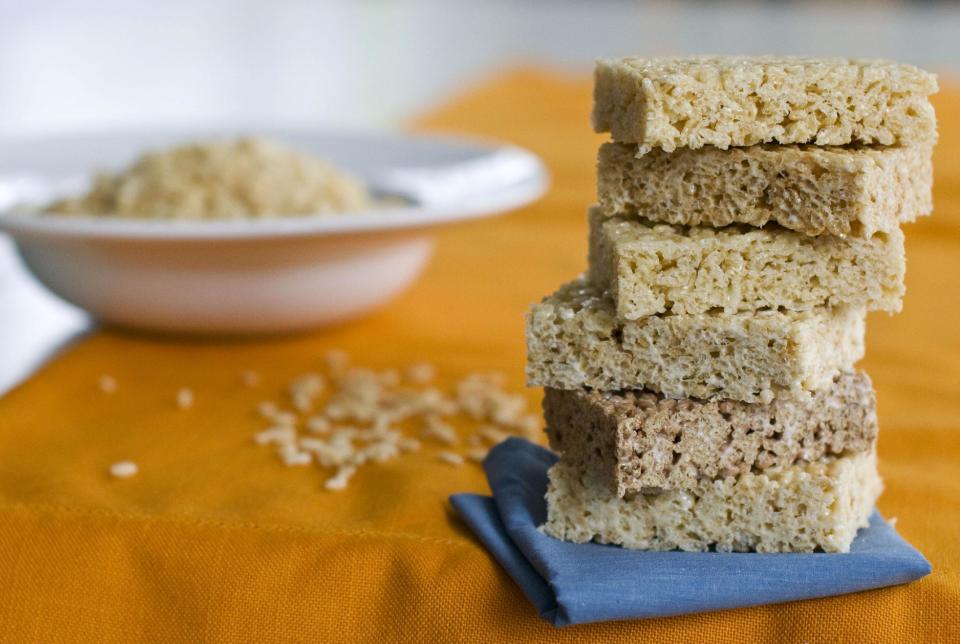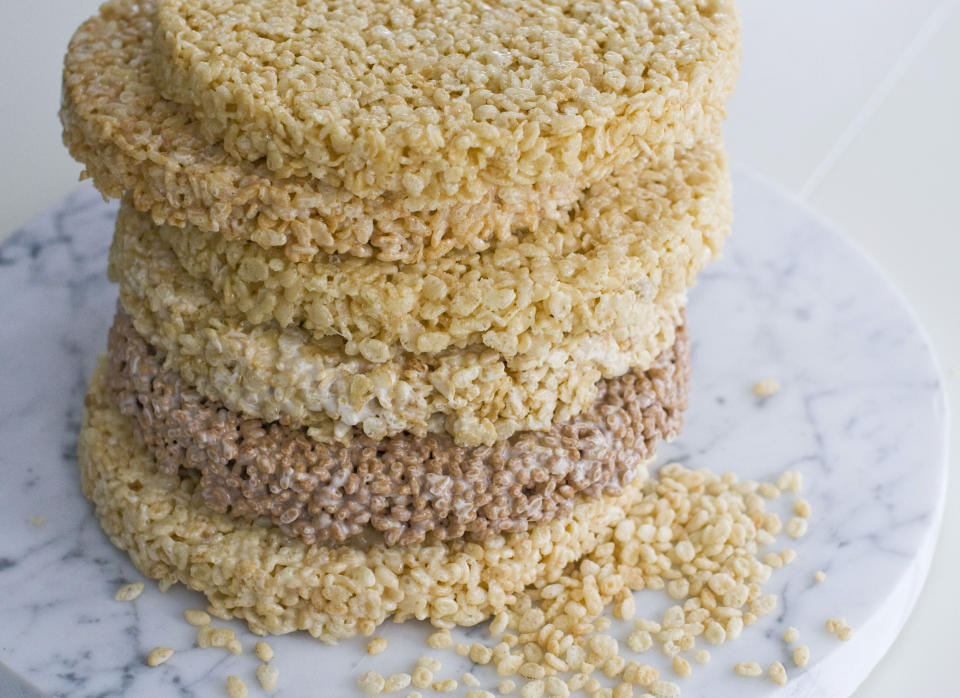A breakfast showdown: Which rice cereal is tops?
Snap!, Crackle! and Pop! are proud to be loud at the breakfast table, but do they fizzle or sizzle in the cereal bowl? And how about in that most ubiquitous of bake sale items — Rice Krispies Treats?
Like so many popular breakfast cereals, Kellogg's Rice Krispies has spawned numerous knockoffs, from gluten-free variants to cocoa-infused crackles. Which got me wondering: Is the mother brand — long pimped by those impish elves named for the noises made by their cereal — still the best choice when filling your bowl and making those bars?
To find out, AP's food team crunched its way through too many boxes of the leading — and some not so — brands of puffy rice cereal. And we were surprised by the results.
But first, a puffed rice cereal primer.
Puffed rice cereals generally are made one of two ways — pressure-expelling or toasting. In the former method, grains of rice are moistened, then cooked in a pressurized device that flash heats them, a process that causes the liquid in them to rapidly expand, creating crunchy, puffy oblongs of rice. You know those giant bags of tasteless puffed cereal sold in natural foods stores? That's this stuff.
When most people think of puffed rice cereal, they think of the stuff made using the toasting method. This involves cooking the rice (often with a sweetener, such as malt flavoring), then partly drying and lightly rolling it. The rice then is toasted somewhere around 650 F, creating porous, crunchy grains that make crackling noises when wet. Variations of this technique are used to make Rice Krispies and its many knockoffs.
In one form or another, puffed rice cereal has been around since the turn of the 20th century. But standard-bearer Rice Krispies wasn't launched until 1928, and Snap! didn't join the marketing team until 1933 (and at the time he resembled a rather scary gnome with a long nose and ears). Within a few years, Crackle! and Pop! joined the effort to push the puff.
While the elves (known as Piff!, Paff! and Puff! in Norway and Sweden, in case you wondered) certainly helped bring Rice Krispies to the American table, it was the popularity of Rice Krispies Treats that transformed the cereal from just another morning carb to a full-blown American culinary icon.
According to company lore, the sticky, chewy bars were first created by Kellogg's employee Mildred Day, supposedly to be sold as a fundraiser for a Camp Fire Girls group. The recipe — cereal, marshmallow and butter — was introduced on cereal boxes in 1940 and has gone pretty much unchanged since then.
What has changed is the number of off-brand variations of the basic cereal. We counted close to a dozen across a handful of grocers in the Northeast. That's a lot of choices for how to make music in your cereal bowl.
Able to ingest only so much crackle, we purchased six of the most common brands, including an organic brown rice version, an organic cocoa-spiked variant, two store brands, the original Rice Krispies and Kellogg's own alternative, Gluten-Free Rice Krispies. We then tried all of them, first in a bowl with whole milk, then in a treat bar (all made using Kellogg's tried and true recipe).
We noticed one thing right off. Three of the six cereals were touted as being gluten-free — Kellogg's Gluten-Free Rice Krispies, Erewhon Crispy Brown Rice (organic) and EnviroKidz Organic Koala Crisp Cereal — and all three of those were made with brown rice, a whole grain. The other three more traditional varieties — which were not gluten-free — were made with white rice, a refined grain.
Turns out, this makes a difference.
Eaten in a bowl of milk, the clear winner was Kellogg's Gluten-Free Rice Krispies. It was pleasantly — but not overbearingly — sweet, with a consistent and lasting crunch with minimal sog-factor. It also snapped and cracked and popped for a solid 40 seconds (yes, we timed it). And parents will appreciate that it has just 1 gram of sugar per 1 cup serving (the original Rice Krispies has 4 grams).
Coming in at No. 2 in the cereal bowl test was the Erewhon entrant, also made from brown rice and with less than 1 gram of sugar per serving. It had a pleasantly nutty favor, a solid crunch that lasted several minutes after the milk was poured. It lost points, however, for making little noise in the bowl and for the occasional overcrunchy grain (they tasted as though they'd been toasted a bit too long).
And Kellogg's original? It came in at No. 3. While a solid contender with the greatest noise factor, it got soggy after just 1 1/2 minutes in milk and didn't have as assertive a crunch as the brown rice versions.
We got similar results in the Rice Krispies Treats test. And yes, we all felt a little sick by the end.
This time, it was a tie for first place. We liked Kellogg's Gluten-Free Rice Krispies and Erewhon Crispy Brown Rice equally well. Both gave the bars a deliciously nutty flavor that paired well with — but didn't overshadow — the sweetness of the marshmallow. The cereals gave the bars a lasting crunch that was a wonderful contrast to the overall chewy texture of the treats. These were what Rice Krispies Treats should be.
Once again in third — but this time a distant third — was Kellogg's original Rice Krispies. Though the taste was fine, the texture was mushy, lacking even a modest crunch.
As for the other three contenders... I'll spare them the humiliation of tallying their weaknesses. Suffice to say, the store brands and the shockingly high sugar Koala Crisp (11 grams per 3/4 cup serving) were not just disappointing, but in the latter case actually unpleasant.
Our conclusion — For reliably good bars and breakfasts, Kellogg's Gluten-Free Rice Krispies are the way to go. If you are looking for an organic option, Erewhon Crispy Brown Rice is an excellent second choice.
Which means that even after more than 80 years, Kellogg's still has a winner. It's just not the winner the company might have expected.
___
EDITOR'S NOTE: Follow AP Food Editor J.M. Hirsch to great eats on Twitter at http://twitter.com/JM_Hirsch or email him at jhirsch(at)ap.org.


